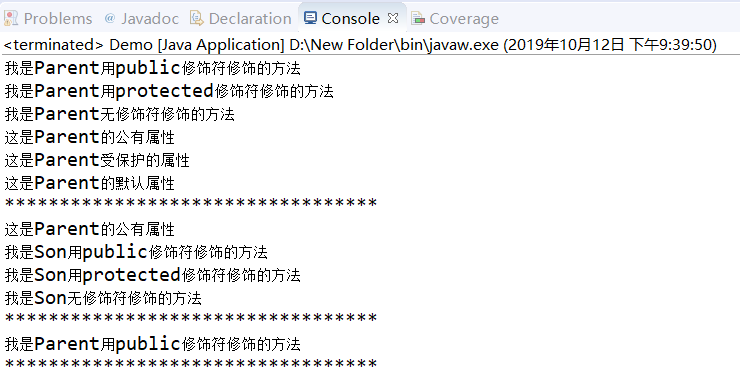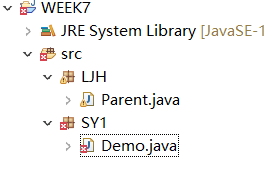201871010111-刘佳华《面向对象程序设计(java)》第七周学习总结
201871010111-刘佳华《面向对象程序设计(java)》第七周学习总结
实验时间 2019-10-11
1、实验目的与要求
1) 掌握四种访问权限修饰符的使用特点;
(1)进一步理解4个成员访问权限修饰符的用途;
A.仅对本类可见-private
B.对所有类可见-public
C.对本包和所有子类可见-protected
D.对本包可见-默认,,不需要修饰符
2) 掌握Object类的用途及常用API;
3) 掌握ArrayList类的定义方法及用法;
4)掌握枚举类定义方法及用途;
5)结合本章实验内容,理解继承与多态性两个面向对象程序设计特征,并体会其优点。
2、实验内容和步骤
实验1: 在“System.out.println(...);”语句处按注释要求设计代码替换...,观察代码录入中IDE提示,以验证四种权限修饰符的用法。
|
class Parent { private String p1 = "这是Parent的私有属性"; public String p2 = "这是Parent的公有属性"; protected String p3 = "这是Parent受保护的属性"; String p4 = "这是Parent的默认属性"; private void pMethod1() { System.out.println("我是Parent用private修饰符修饰的方法"); } public void pMethod2() { System.out.println("我是Parent用public修饰符修饰的方法"); } protected void pMethod3() { System.out.println("我是Parent用protected修饰符修饰的方法"); } void pMethod4() { System.out.println("我是Parent无修饰符修饰的方法"); } } class Son extends Parent{ private String s1 = "这是Son的私有属性"; public String s2 = "这是Son的公有属性"; protected String s3 = "这是Son受保护的属性"; String s4 = "这是Son的默认属性"; public void sMethod1() { System.out.println(...);//分别尝试显示Parent类的p1、p2、p3、p4值 System.out.println("我是Son用public修饰符修饰的方法"); } private void sMethod2() { System.out.println("我是Son用private修饰符修饰的方法"); } protected void sMethod() { System.out.println("我是Son用protected修饰符修饰的方法"); } void sMethod4() { System.out.println("我是Son无修饰符修饰的方法"); } } public class Demo { public static void main(String[] args) { Parent parent=new Parent(); Son son=new Son(); System.out.println(...); //分别尝试用parent调用Paren类的方法、用son调用Son类的方法 } } |
public class Demo {
public static void main(String[] args) {
Parent parent=new Parent();
Son son=new Son();
//System.out.println(...); //分别尝试用parent调用Parent类的方法、访问值;
parent.pMethod2();
parent.pMethod3();
parent.pMethod4();//由于pMethod1为私有的,所以不能用parent.pMethod1调用
System.out.println(parent.p2);
System.out.println(parent.p3);
System.out.println(parent.p4);
System.out.println("**********************************");
//用son调用Son类的方法
son.sMethod1();
son.sMethod3();
son.sMethod4();
System.out.println("**********************************");
//用son调用parent类的方法
son.pMethod2();
System.out.println("**********************************");
}
}
Demo
package SY1;
public class Parent {
private String p1 = "这是Parent的私有属性";
public String p2 = "这是Parent的公有属性";
protected String p3 = "这是Parent受保护的属性";
String p4 = "这是Parent的默认属性";
private void pMethod1() {
System.out.println("我是Parent用private修饰符修饰的方法");
}
public void pMethod2() {
System.out.println("我是Parent用public修饰符修饰的方法");
}
protected void pMethod3() {
System.out.println("我是Parent用protected修饰符修饰的方法");
}
void pMethod4() {
System.out.println("我是Parent无修饰符修饰的方法");
}
}
Parent
package SY1;
Public class Son extends Parent{
private String s1 = "这是Son的私有属性";
public String s2 = "这是Son的公有属性";
protected String s3 = "这是Son受保护的属性";
String s4 = "这是Son的默认属性";
public void sMethod1() {
System.out.println(p2);//分别尝试显示Parent类的p1、p2、p3、p4值
System.out.println("我是Son用public修饰符修饰的方法");
}
private void sMethod2() {
System.out.println("我是Son用private修饰符修饰的方法");
}
protected void sMethod3() {
System.out.println("我是Son用protected修饰符修饰的方法");
}
void sMethod4() {
System.out.println("我是Son无修饰符修饰的方法");
}
}
Son
运行截图:

@@当新建一个以LJH的包,把Parent.java文件移动到LJH的包中时,通过在Damo.java 中加入import LJH.Parent;
但是由于Damo.java和Parent.java 不在同一个包中,一些属性及方法将在访问时产生错误,这也让我深刻认识到了权限修饰符的作用;如下图:


实验2:导入第5章以下示例程序,测试并进行代码注释。
测试程序1:
l 运行教材程序5-8、5-9、5-10,结合程序运行结果理解程序(教材174页-177页);
l 删除程序中Employee类、Manager类中的equals()、hasCode()、toString()方法,背录删除方法,在代码录入中理解类中重写Object父类方法的技术要点。
package equals; import java.time.*;
import java.util.Objects; public class Employee
{
private String name;
private double salary;
private LocalDate hireDay; public Employee(String name, double salary, int year, int month, int day)
{
this.name = name;
this.salary = salary;
hireDay = LocalDate.of(year, month, day);
} public String getName()
{
return name;
} public double getSalary()
{
return salary;
} public LocalDate getHireDay()
{
return hireDay;
} public void raiseSalary(double byPercent)
{
double raise = salary * byPercent / 100;
salary += raise;
} public boolean equals(Object otherObject)
{
// 快速测试,看看这些对象是否相同
if (this == otherObject) return true; // 如果显式参数为空,则必须返回false
if (otherObject == null) return false; // 如果类不匹配,它们就不能相等
if (getClass() != otherObject.getClass()) return false; // 现在我们知道otherObject是一个非空雇员
var other = (Employee) otherObject; // 测试字段是否具有相同的值
return Objects.equals(name, other.name)
&& salary == other.salary && Objects.equals(hireDay, other.hireDay);
} public int hashCode()
{
return Objects.hash(name, salary, hireDay);
} public String toString()
{
return getClass().getName() + "[name=" + name + ",salary=" + salary + ",hireDay="
+ hireDay + "]";
}
}
Employee
package equals; /**
* This program demonstrates the equals method.
* @version 1.12 2012-01-26
* @author Cay Horstmann
*/
public class EqualsTest
{
public static void main(String[] args)
{
var alice1 = new Employee("Alice Adams", 75000, 1987, 12, 15);
var alice2 = alice1;
var alice3 = new Employee("Alice Adams", 75000, 1987, 12, 15);
var bob = new Employee("Bob Brandson", 50000, 1989, 10, 1); System.out.println("alice1 == alice2: " + (alice1 == alice2)); System.out.println("alice1 == alice3: " + (alice1 == alice3)); System.out.println("alice1.equals(alice3): " + alice1.equals(alice3)); System.out.println("alice1.equals(bob): " + alice1.equals(bob)); System.out.println("bob.toString(): " + bob); var carl = new Manager("Carl Cracker", 80000, 1987, 12, 15);
var boss = new Manager("Carl Cracker", 80000, 1987, 12, 15);
boss.setBonus(5000);
System.out.println("boss.toString(): " + boss);
System.out.println("carl.equals(boss): " + carl.equals(boss));
System.out.println("alice1.hashCode(): " + alice1.hashCode());
System.out.println("alice3.hashCode(): " + alice3.hashCode());
System.out.println("bob.hashCode(): " + bob.hashCode());
System.out.println("carl.hashCode(): " + carl.hashCode());
}
}
EqualsTest
package equals; public class Manager extends Employee
{
private double bonus; public Manager(String name, double salary, int year, int month, int day)
{
super(name, salary, year, month, day);
bonus = 0;
} public double getSalary()
{
double baseSalary = super.getSalary();
return baseSalary + bonus;
} public void setBonus(double bonus)
{
this.bonus = bonus;
} @Override
public boolean equals(Object otherObject) {
// TODO Auto-generated method stub
if (!super.equals(otherObject)) return false;
var other = (Manager) otherObject;
// super.equals检查这个和其他属于同一个类
return bonus == other.bonus;
} @Override
public int hashCode() {
// TODO Auto-generated method stub
return super.hashCode();
} @Override
public String toString() {
// TODO Auto-generated method stub
return super.toString();
} /*public boolean equals(Object otherObject)
{
if (!super.equals(otherObject)) return false;
var other = (Manager) otherObject;
// super.equals checked that this and other belong to the same class
return bonus == other.bonus;
} public int hashCode()
{
return java.util.Objects.hash(super.hashCode(), bonus);
} public String toString()
{
return super.toString() + "[bonus=" + bonus + "]";
}*/
}
Manager
运行结果:

测试程序2:
l 在elipse IDE中调试运行程序5-11(教材182页),结合程序运行结果理解程序;
l 掌握ArrayList类的定义及用法;
l 在程序中相关代码处添加新知识的注释;
l 设计适当的代码,测试ArrayList类的set()、get()、remove()、size()等方法的用法。
package arrayList; import java.util.*; /**
* This program demonstrates the ArrayList class.
* @version 1.11 2012-01-26
* @author Cay Horstmann
*/
public class ArrayListTest
{
public static void main(String[] args)
{
// 用三个Employee对象填充staff数组列表
var staff = new ArrayList<Employee>(); staff.add(new Employee("Carl Cracker", 75000, 1987, 12, 15));
staff.add(new Employee("Harry Hacker", 50000, 1989, 10, 1));
staff.add(new Employee("Tony Tester", 40000, 1990, 3, 15)); // 把每个人的薪水提高5%
for (Employee e : staff)
e.raiseSalary(5); // 打印所有Employee对象的信息
for (Employee e : staff)
System.out.println("name=" + e.getName() + ",salary=" + e.getSalary() + ",hireDay="
+ e.getHireDay());
}
}
ArrayListTest
package arrayList; import java.time.*; public class Employee
{
private String name;
private double salary;
private LocalDate hireDay; public Employee(String name, double salary, int year, int month, int day)
{
this.name = name;
this.salary = salary;
hireDay = LocalDate.of(year, month, day);
} public String getName()
{
return name;
} public double getSalary()
{
return salary;
} public LocalDate getHireDay()
{
return hireDay;
} public void raiseSalary(double byPercent)
{
double raise = salary * byPercent / 100;
salary += raise;
}
}
Employee
运行结果:

更改后的ArrayListTest代码如下:
package arrayList; import java.util.*; /**
* This program demonstrates the ArrayList class.
* @version 1.11 2012-01-26
* @author Cay Horstmann
*/
public class ArrayListTest
{
public static void main(String[] args)
{
// 用三个Employee对象填充staff数组列表
var staff = new ArrayList<Employee>(); staff.add(new Employee("Carl Cracker", 75000, 1987, 12, 15));
staff.add(new Employee("Harry Hacker", 50000, 1989, 10, 1));
staff.add(new Employee("Tony Tester", 40000, 1990, 3, 15)); System.out.println(staff.get(1));
staff.set(1, new Employee("liujiahua", 50000, 2019, 10, 11));
System.out.println(staff.size());
staff.remove(2); // 把每个人的薪水提高5%
for (Employee e : staff)
e.raiseSalary(5); // 打印所有Employee对象的信息
for (Employee e : staff)
System.out.println("name=" + e.getName() + ",salary=" + e.getSalary() + ",hireDay="
+ e.getHireDay());
}
}
new ArrayListTest
运行代码之后截图:
可以看到,在修改代码之后运行可以看出,通过get()方法获得下标为1的元素储存位置,即地址通过;set()方法,修改在ArrayList<>中下标1添加new Employee("liujiahua", 50000, 2019, 10, 11);
通过get()方法获得数组下标为1的元素输出、通过remove()方法删除下标为2的数组元素、并且通过size()方法代替.length得到数组的长度。

测试程序3:
l 编辑、编译、调试运行程序5-12(教材189页),结合运行结果理解程序;
l 掌握枚举类的定义及用法;
l 在程序中相关代码处添加新知识的注释;
l 删除程序中Size枚举类,背录删除代码,在代码录入中掌握枚举类的定义要求。
package enums; import java.util.*; /**
* This program demonstrates enumerated types.
* @version 1.0 2004-05-24
* @author Cay Horstmann
*/
public class EnumTest
{
public static void main(String[] args)
{
var in = new Scanner(System.in);
System.out.print("Enter a size: (SMALL, MEDIUM, LARGE, EXTRA_LARGE) ");
String input = in.next().toUpperCase();
Size size = Enum.valueOf(Size.class, input);
System.out.println("size=" + size);
System.out.println("abbreviation=" + size.getAbbreviation());
if (size == Size.EXTRA_LARGE)
System.out.println("Good job--you paid attention to the _.");
}
} enum Size
{
SMALL("S"), MEDIUM("M"), LARGE("L"), EXTRA_LARGE("XL"); private Size(String abbreviation) { this.abbreviation = abbreviation; }
public String getAbbreviation() { return abbreviation; } private String abbreviation; }
EnumTest
运行结果:

测试程序4:录入以下代码,结合程序运行结果了解方法的可变参数用法
|
public class TestVarArgus { public static void dealArray(int... intArray){ for (int i : intArray) System.out.print(i +" "); System.out.println(); } public static void main(String args[]){ dealArray(); dealArray(1); dealArray(1, 2, 3); dealArray(1, 2, 3, 4); dealArray(1, 2, 3, 4, 5); dealArray(1, 2, 3, 4, 5, 6); } } |
运行截图:

实验:3:编程练习:参照输出样例补全程序,使程序输出结果与输出样例一致。
|
public class Demo { public static void main(String[] args) { Son son = new Son(); son.method(); } } class Parent { Parent() { System.out.println("Parent's Constructor without parameter"); } Parent(boolean b) { System.out.println("Parent's Constructor with a boolean parameter"); } public void method() { System.out.println("Parent's method()"); } } class Son extends Parent { //补全本类定义 } |
程序运行结果如下:
Parent's Constructor with a boolean parameter
Son's Constructor without parameter
Son's method()
Parent's method()
代码如下:
package LJH;
public class Demo {
public static void main(String[] args) {
Son son = new Son();
son.method();
}
}
class Parent {
Parent() {
System.out.println("Parent's Constructor without parameter");
}
Parent(boolean b) {
System.out.println("Parent's Constructor with a boolean parameter");
}
public void method() {
System.out.println("Parent's method()");
}
}
class Son extends Parent {
void Parent() {
System.out.println("Son's Constructor without parameter");
}
public void method() {
Parent();
System.out.println("Son's method()");
super.method();
}
//补全本类定义
}
/*
Parent's Constructor with a boolean parameter
Son's Constructor without parameter
Son's method()
Parent's method()*/
Demo
运行结果:

实验总结:
通过本周的实验,我掌握理解了成员访问权限的四个修饰符,Object类和ArrayList类的常用方法,API以及枚举使用方法。在处理一些问题中,我了解到了我的不足,编程能力还远远不行。在继承学习中,仍有一些父类和子类的关系没搞懂;继承程序构造技术还不太熟练,需要继续学习巩固。
201871010111-刘佳华《面向对象程序设计(java)》第七周学习总结的更多相关文章
- 201771010134杨其菊《面向对象程序设计java》第九周学习总结
第九周学习总结 第一部分:理论知识 异常.断言和调试.日志 1.捕获 ...
- 201871010132-张潇潇《面向对象程序设计(java)》第一周学习总结
面向对象程序设计(Java) 博文正文开头 项目 内容 这个作业属于哪个课程 https://www.cnblogs.com/nwnu-daizh/ 这个作业的要求在哪里 https://www.cn ...
- 扎西平措 201571030332《面向对象程序设计 Java 》第一周学习总结
<面向对象程序设计(java)>第一周学习总结 正文开头: 项目 内容 这个作业属于哪个课程 https://www.cnblogs.com/nwnu-daizh/ 这个作业的要求在哪里 ...
- 杨其菊201771010134《面向对象程序设计Java》第二周学习总结
第三章 Java基本程序设计结构 第一部分:(理论知识部分) 本章主要学习:基本内容:数据类型:变量:运算符:类型转换,字符串,输入输出,控制流程,大数值以及数组. 1.基本概念: 1)标识符:由字母 ...
- 201871010124 王生涛《面向对象程序设计JAVA》第一周学习总结
项目 内容 这个作业属于哪个课程 https://www.cnblogs.com/nwnu-daizh/ 这个作业的要求在哪里 https://edu.cnblogs.com/campus/xbsf/ ...
- 201871010115——马北《面向对象程序设计JAVA》第二周学习总结
项目 内容 这个作业属于哪个课程 https://www.cnblogs.com/nwnu-daizh/ 这个作业的要求在哪里 https://www.cnblogs.com/nwnu-daizh/p ...
- 201777010217-金云馨《面向对象程序设计(Java)》第二周学习总结
项目 内容 这个作业属于哪个课程 https://www.cnblogs.com/nwnu-daizh/ 这个作业的要求在哪里 https://www.cnblogs.com/nwnu-daizh/p ...
- 201871010132——张潇潇《面向对象程序设计JAVA》第二周学习总结
项目 内容 这个作业属于哪个课程 https://www.cnblogs.com/nwnu-daizh/ 这个作业的要求在哪里 https://www.cnblogs.com/nwnu-daizh/p ...
- 201771010123汪慧和《面向对象程序设计Java》第二周学习总结
一.理论知识部分 1.标识符由字母.下划线.美元符号和数字组成, 且第一个符号不能为数字.标识符可用作: 类名.变量名.方法名.数组名.文件名等.第二部分:理论知识学习部分 2.关键字就是Java语言 ...
- 201521123061 《Java程序设计》第七周学习总结
201521123061 <Java程序设计>第七周学习总结 1. 本周学习总结 2. 书面作业 ArrayList代码分析 1.1 解释ArrayList的contains源代码 贴上源 ...
随机推荐
- STL 中 string 的使用
赋值 string 类型变量可以直接赋值 str = "string"; // str 是 一个 string 类型变量 //等价于 str.assign("string ...
- navicat premium 12 破解,本人亲测有效,针对error on decrypt request code的解决方法
好,废话不多说,直接上步骤: 下载安装Navicat 由于本人信服官网的东西,所以Navicat premium12是在官网上边下载.下载地址:https://www.navicat.com.cn/p ...
- MongoDB学习笔记(三、MongoDB聚合与更新)
目录: 聚合 更新 更新选择器 ObjectId 更新操作的原子性 聚合: 聚合语法:db.collectionName.aggregate(aggregate_operation) 聚合操作其实就是 ...
- IDEA springboot配置
基于springboot2.1.7 springboot项目创建 springboot热部署 springboot配置swagger2 springboot配置mybatis springboot配置 ...
- Python程序中的进程操作-进程间通信(multiprocess.Queue)
目录 一.进程间通信 二.队列 2.1 概念介绍--multiprocess.Queue 2.1.1 方法介绍 2.1.2 其他方法(了解) 三.代码实例--multiprocess.Queue 3. ...
- PHP 7.4.0 发布
近日,PHP 7.4.0 发布了,此版本标志着 PHP 7 系列的第四次特性更新. PHP 7.4.0 进行了许多改进,并带来了一些新特性,包括: Typed Properties 类型属性 类属性 ...
- 《细说PHP》 第四版 样章 第二章 PHP的应用与发展 5
2.5 如何学习PHP PHP以其简单易学的特点,以及敏捷开发的优势,从一个几乎不被人知的开源项目,慢慢成长为技术人员首选的动态Web设计工具,与其他语言相比,PHP表现得更好.更快.更简单易学.尽 ...
- Linux网络基础协议和ip管理
1.简述osi七层模型和TCP/IP五层模型 osi七层模型分别是:物理层.数据链路层.网络层.传输层.会话层.表示层.应用层. 1)物理层:这一层的主要功能是二进制传输数据,界定连接器和网线的规格: ...
- 解决centos下tomcat启动太慢 & JDBC连接oracle太慢的问题
近期遇到一个非常奇怪的问题,也不知道改了什么,tomcat启动非常慢,以前几秒就启动好了,现在要30秒左右. 而且,通过jdbc连接oracle数据库也非常慢,以前建立一个连接只要几十毫秒,现在也要1 ...
- SpringBoot 和Vue前后端分离入门教程(附源码)
作者:梁小生0101 juejin.im/post/5c622fb5e51d457f9f2c2381 推荐阅读(点击即可跳转阅读) 1. SpringBoot内容聚合 2. 面试题内容聚合 3. 设计 ...
